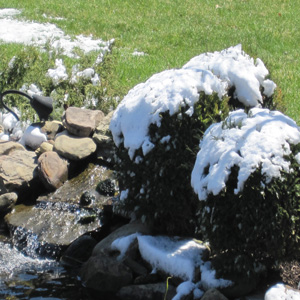 This is what some of us in the North woke up to this morning, and this was after some of it had melted. What happened to those 50 and 60 degree days??? Hopefully they will be back again soon. How can we get started cleaning our ponds and thinking putting those new plants in if the water is too cold to put our hand in it. And what about those fish and frogs???? They are hiding again.
This is what some of us in the North woke up to this morning, and this was after some of it had melted. What happened to those 50 and 60 degree days??? Hopefully they will be back again soon. How can we get started cleaning our ponds and thinking putting those new plants in if the water is too cold to put our hand in it. And what about those fish and frogs???? They are hiding again.
Whenever this happens, those of us who wanted our plants shipped thinking its finally warm wonder, now what do I do with them. Make sure you protect them by bringing them indoors until it warms up. Remember most of the plants have been indoors in a greenhouse environment and shiver even when the temps are in the 60s. But we need to make sure the water temperature have stabilized to 65 degrees before we put those floating plants out.
The floating water plants in your pond need to have the water temperature reach 65 degrees. They will show signs of yellowing leaves and black spots on their leaves if left in water temps below that. The water lettuce will wilt and turn white if too cold. We tend to get anxious in the spring and sometimes put floaters in before the water is warm enough. Even the lotus and waterlilies need the warmer weather to start growing. But at least those were outside all winter and were pulled to ship out.
Hopefully, like last year, this is a short spell and in a couple weeks things will turn around and we can once again start looking forward to enjoying our ponds.
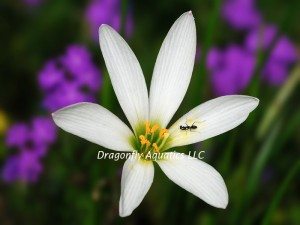 As we get ready for another season, Dragonfly Aquatics is currently working on adding some new plants for the 2010 season. In the upcoming weeks we will be announcing our new plant varieties.
As we get ready for another season, Dragonfly Aquatics is currently working on adding some new plants for the 2010 season. In the upcoming weeks we will be announcing our new plant varieties.
The first we've added are our new Lotus for 2010. The Penelope and Double Rose. The Penelope is a pure white lotus and the Double Rose is a pink full lotus. Both are a great addition to our store. You can find more information on them on our site. https://www.dragonflyaquatics.com/lotus.html
The newest bog plant we've added this year is the Rain Lily or Zephyranthes candida. They have six-petaled flowers that are 1-3 inches across with grassy foliage and grow 3 - 10 inches tall. They grow in full sun to part shade in moist soil or water to 3 inches deep. They are a tender perennial bulbs and hardy in Zone 8 and up. They have however, survived in Zones 5 or 6. You can winter these over by taking them indoors. Just don't water them until you return them to the pond in the spring. They go dormant in the dry season and grow and flower in the wet season.
You can purchase Rain Lilies here on sale through end of March, 2010.
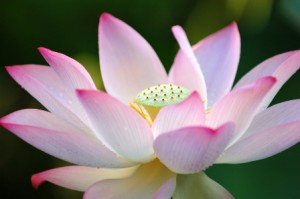 In March we begin harvesting the lotus tubers for the 2010 season. In the next couple weeks most varieties will be available for shipping to planting zones 10, 9 and 8. Lotus tubers are pulled while they are still dormant. The lotus tubers we sell at Dragonfly Aquatics have at least three or more growing tips, sometimes more depending on the variety. The tubers are kept in the dormant state in cold water until it is time to ship to your zone. Once the lotus tuber is placed in 65 - 70 degree water in the sun, it will begin to grow once again. Most varieties will bloom the first season.
In March we begin harvesting the lotus tubers for the 2010 season. In the next couple weeks most varieties will be available for shipping to planting zones 10, 9 and 8. Lotus tubers are pulled while they are still dormant. The lotus tubers we sell at Dragonfly Aquatics have at least three or more growing tips, sometimes more depending on the variety. The tubers are kept in the dormant state in cold water until it is time to ship to your zone. Once the lotus tuber is placed in 65 - 70 degree water in the sun, it will begin to grow once again. Most varieties will bloom the first season.
You can read about planting lotus on our blog.
Check out the lotus on our site.
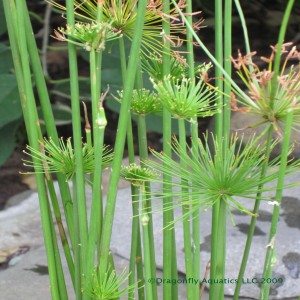 Dwarf Papyrus is a perfect plant for tub gardens or table top container ponds. While the dwarf is a perfect smaller plant for container gardening or smaller ponds if you have a large pond you might want to stick with the larger variety, Dwarf Giant Papyrus which grows about 3 ft tall.
Dwarf Papyrus is a perfect plant for tub gardens or table top container ponds. While the dwarf is a perfect smaller plant for container gardening or smaller ponds if you have a large pond you might want to stick with the larger variety, Dwarf Giant Papyrus which grows about 3 ft tall.
Our Dwarf Papyrus are really nice plants this year. Each now approximately 12" high. This plant is compact with tight tufts of green strands on top of the stems. Height 12-18 inches and spread about 6-12 inches. It requires sun to part shade and moist soil or water up to 4 inches deep.
Dwarf Papyrus is viviparous and will grow new plants from the tops. You can easily winter this plant over indoors as a houseplant in a sunny spot as long as you keep the soil moist at all times but don't submerge the crown. You would want to keep the winter temperature above 50 degrees.
Buy Dwarf Papyrus,bog plant here.
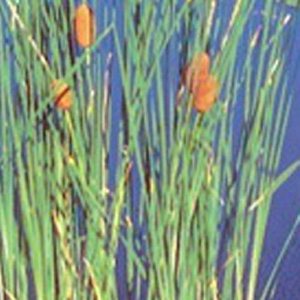 Dwarf Cattails are popular with most of our customers. They are ideal for smaller ponds and container water gardens as well as the regular ponds. They grow in sun to part shade in moist soil or water to just 5 inches deep. Dwarf cattails grow to only about 36 inches in height and do well in Zones 3-10 and will tolerate water over their crown. The foliage on the dwarf cattail is very narrow and it has small catkins. Cattails can be grown from seed, but they propagate quickly from dividing their rhizomes.
Dwarf Cattails are popular with most of our customers. They are ideal for smaller ponds and container water gardens as well as the regular ponds. They grow in sun to part shade in moist soil or water to just 5 inches deep. Dwarf cattails grow to only about 36 inches in height and do well in Zones 3-10 and will tolerate water over their crown. The foliage on the dwarf cattail is very narrow and it has small catkins. Cattails can be grown from seed, but they propagate quickly from dividing their rhizomes.
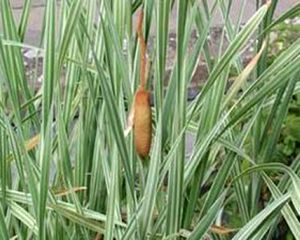 Variegated cattail, Typha latifolia 'Variegata' is an attractive bog plant for any pond. The variegation in this cattail is bold forming bright green and white longitudinal stripes. The Variegated Cattail will grow to 5 feet tall in sun to part shade. It requires moist soil or water to 12 inches deep. It does well in Zones 4-11. The Variegated Cattail doesn't grow as readily as the other cattails and doesn't like to be transplanted.
Variegated cattail, Typha latifolia 'Variegata' is an attractive bog plant for any pond. The variegation in this cattail is bold forming bright green and white longitudinal stripes. The Variegated Cattail will grow to 5 feet tall in sun to part shade. It requires moist soil or water to 12 inches deep. It does well in Zones 4-11. The Variegated Cattail doesn't grow as readily as the other cattails and doesn't like to be transplanted.
The Variegated Cattail is a nice addition to any pond and provides a taller backdrop for smaller plants around your pond. In addition, it also is a great pond plant that will attract dragonflies and other wildlife to your water garden.
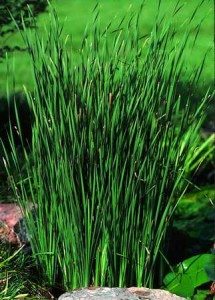 Graceful Cattails, Typha angustifolia are similar to your regular Common Cattail other than its leaves. They are more narrow leafed than the standard and the foliage arches and sways gracefully in the breeze. An elegant bog pond plant and is suitable for any pond or large container water garden. They will grow 4-6 feet tall and their catkins are very thin. The foliage makes an attractive cutting for any floral arrangement.
Graceful Cattails, Typha angustifolia are similar to your regular Common Cattail other than its leaves. They are more narrow leafed than the standard and the foliage arches and sways gracefully in the breeze. An elegant bog pond plant and is suitable for any pond or large container water garden. They will grow 4-6 feet tall and their catkins are very thin. The foliage makes an attractive cutting for any floral arrangement.
Graceful Cattails grow in sun to part shade in moist soil to water 12 inches deep and do well in Zones 3-11. They don't mind having water above their crown even during winter months and tolerate freezing temperatures well. Again Graceful Cattails are the same as other cattails and will propagate quickly from division of the rhizomes or easily grown by seed.
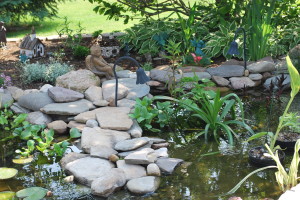 Well, I personally do not want to believe it.....but, the calendar does not lie! It's September 21st, and fall is scheduled to arrive tomorrow. With that being said, there are some things you will want to do to ensure your pond and aquatic inhabitants survive the Winter ahead. Before winter arrives, you will want to make sure your pond and filtering system are clean to ensure good water quality throughout the winter months. With the arrival of fall it is wise to do a partial water change to remove any built up contaminants to improve water quality. Partial water changes need to be made before water temperatures fall below 60 degrees to minimize fish stress. Adding pond salt at this time will improve the slime coating of your fish, to help them ward off disease and parasites.
Well, I personally do not want to believe it.....but, the calendar does not lie! It's September 21st, and fall is scheduled to arrive tomorrow. With that being said, there are some things you will want to do to ensure your pond and aquatic inhabitants survive the Winter ahead. Before winter arrives, you will want to make sure your pond and filtering system are clean to ensure good water quality throughout the winter months. With the arrival of fall it is wise to do a partial water change to remove any built up contaminants to improve water quality. Partial water changes need to be made before water temperatures fall below 60 degrees to minimize fish stress. Adding pond salt at this time will improve the slime coating of your fish, to help them ward off disease and parasites.
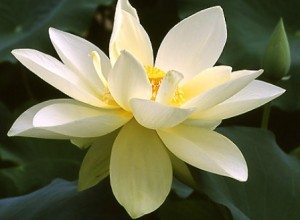 As the lotus leaves begin to turn brown, the lotus is beginning to go dormant for the winter. Do not cut off the leaves; allow them to die back naturally. At this point, it is safe to cut them off above the water line. You do not want water getting down the hollow green stem and having it get into the air channels of the tuber, if this happens you risk drowning the tuber, which will cause it to rot. Make sure the potted lotus is below the ice. Allowing the tuber to freeze will kill the plant.
As the lotus leaves begin to turn brown, the lotus is beginning to go dormant for the winter. Do not cut off the leaves; allow them to die back naturally. At this point, it is safe to cut them off above the water line. You do not want water getting down the hollow green stem and having it get into the air channels of the tuber, if this happens you risk drowning the tuber, which will cause it to rot. Make sure the potted lotus is below the ice. Allowing the tuber to freeze will kill the plant.
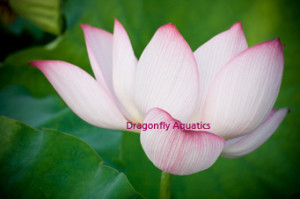 Those who have lotus are now enjoying the sun loving water plant that thrives in hot weather and high humidity.
Those who have lotus are now enjoying the sun loving water plant that thrives in hot weather and high humidity.
The unique lotuses are hardy water plants that can be wintered over even in the coldest of climates. Caring for your lotus as the season comes to an end is important. You want to cut back the foliage to the water surface after the leaves have all died and turned brown. If you cut them back while they are still green, bacteria or fungal infections can reach the underground tuber and can kill the plant.
The care given to the lotus is much similiar to the care of your hardy water lilies, keeping the tubers deep enough in the pond that the ice and frost will not reach them. It is easier to accomplish this with lotus in a shallow pond than it is with hardy water lilies. The lotus roots grow at the bottom of the pot, while your water lilies rhizomes are often at the soil surface.
If you choose not to overwinter your lotus in your pond you can put the pot in a trash bag and store it where it will stay cool, dark and damp. Making sure it doesn't freeze.